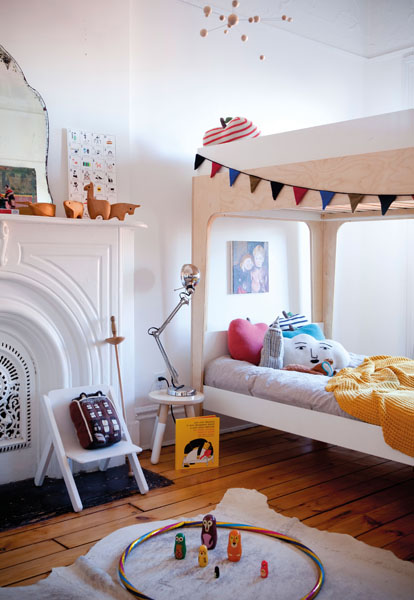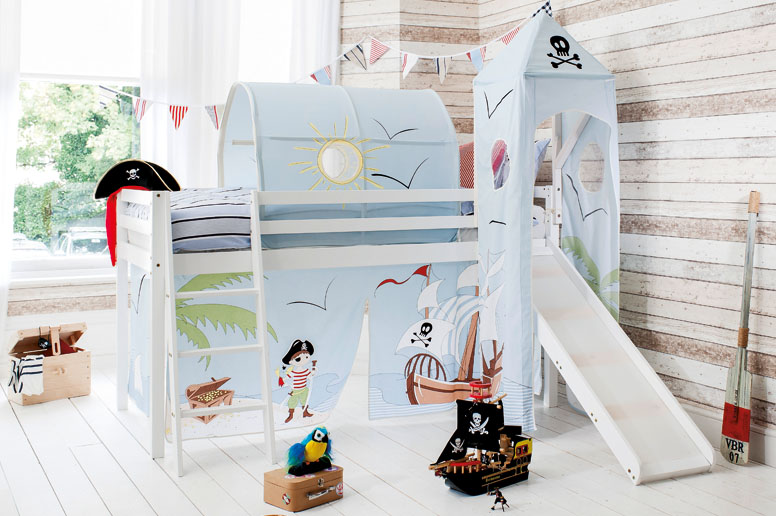Like no other room in the house, a child’s room has a multitude of functions. It’s a playroom, a den, a place to do homework, a retreat to daydream and somewhere to sleep (only if they must, of course). It is also one of the only rooms that will need to continuously adapt to differing needs over time, as your children grow.
With some clever design tips and a few investment buys, however, you can design a room that will evolve with their changing needs, with just a few simple adjustments.
While practicality is key, it’s also essential to remember the fun factor. Get your children involved in the planning stages and show them a variety of options before agreeing on a theme or a colour. It should result in them having an emotional investment in the room they helped design, and so they will be less likely to want to change it after a year or so. What’s more, building a creative space for them will also encourage creative minds to develop.
Decorating a child’s bedroom should be a fun experience. Whether you go for a striking colour scheme, a specific theme for the room or a neutral backdrop to highlight colourful accessories, remember to consult with your child – their imagination may run wild, but can always be tailored and harnessed to keep everyone happy.
Bernice Say, director of luxury homeware store Oliver Hayden, gives her styling tips: “Start by listing the colours and the things your child loves. Does he/she like numbers, shapes, cars or dolls? You can then incorporate these elements. Choose a neutral or subtle colour for the walls with your child, and get it painted.
“Don’t worry too much if your child is veering towards bright colours. Direct your child back to the subtle, after all, your child must be able to sleep in the room at night! Then, choose a wall to showcase a piece of artwork. Get a large stretched canvas and some paint and give it to your child to get creative. This will be their masterpiece – something they will be proud of. Be sure to incorporate accessible shelving for books and toys.
“Lastly, I always like to create a ‘cushion area’ for either the bed or floor, as a little zone for them to relax.”
 Sarah Cole, director of the heritage brand at Farrow & Ball, now with a branch in Cambridge, agrees with choosing an adaptable colour as a foundation for the room. “We’ve found that the key to decorating young people’s rooms, from nurseries to teenage bedrooms, is to use colours and patterns that will grow with them. For example, if you have a little girl who is determined that only pink will do, but you know she may well grow out of the ‘pink phase’ as soon as you’ve put down the paintbrush, why not compromise by using a neutral colour like Great White on the walls and ceilings and painting the door, woodwork and accessories in Cinder Rose? That way, when she’s moved on to other colours, it will be easier for you to update her room.
Sarah Cole, director of the heritage brand at Farrow & Ball, now with a branch in Cambridge, agrees with choosing an adaptable colour as a foundation for the room. “We’ve found that the key to decorating young people’s rooms, from nurseries to teenage bedrooms, is to use colours and patterns that will grow with them. For example, if you have a little girl who is determined that only pink will do, but you know she may well grow out of the ‘pink phase’ as soon as you’ve put down the paintbrush, why not compromise by using a neutral colour like Great White on the walls and ceilings and painting the door, woodwork and accessories in Cinder Rose? That way, when she’s moved on to other colours, it will be easier for you to update her room.
“Wallpaper is also an interesting addition to consider; a feature wall of wallpaper is often a popular choice among parents as it’s easy to update as children grow. “To create a calming atmosphere, the subtle tones and pattern of Vermicelli is great for nurseries; stimulating young babies and helping to lull them o to the land of nod. Wallpaper also works well across all ages. Bumble Bee is a great way to create an animal friendly room for younger children, whereas Ocelot is a great choice for teenagers making a statement.
“Children’s playrooms and dens are a great place to be bold and have fun with colour. Bright colours like Rectory Red, Charlotte’s Locks, Yellowcake, St Giles Blue and Arsenic are brilliant colours to add vibrancy to a room and create pops of colour. You don’t have to use them on the walls, apply these colours on stools, chairs and tables to create a happy environment for your child to play in.”
From quirky wallpapers to practical wall stickers, available at Peanut and Pip, these days décor is increasingly sophisticated for the young. Perfect for a feature wall, and educational, are the map murals available at Maps International. You can also dress a child’s room with pretty bed linens and cushions made from textiles that don’t meet the usual ‘pink for girls’ and ‘blue for boys’.
Lastly, let’s not forget the all-important aspect of sleeping. Vital for any child – and parent – is ensuring the little ones have an uninterrupted night’s sleep. Invest in a night light, to ward o ff night-time terrors (there are lovely animal versions at White Rabbit England) and make sure you fit the room with blackout blinds or curtains.
Sarah Quilliam, head of product design at blind experts Hillarys adds: “Blinds with a blackout function are a great choice for kids’ rooms. They make it much easier to settle small children on light evenings and should help stop them waking up at dawn in the summer months. Blackout roller blinds also allow you to let in as much natural light as possible at other times. Ensure that safety devices are fitted to keep control chains taut and out of harm’s reach or choose a window dressing that doesn’t have any cords such as shutters, a tabbed pleated blind or have roller or Venetian blinds fitted in a perfect fit frame.”
No matter what design you choose – and the scope is endless – a child’s room is their first ‘room of their own’, and one they will recall forever. No pressure, now!

